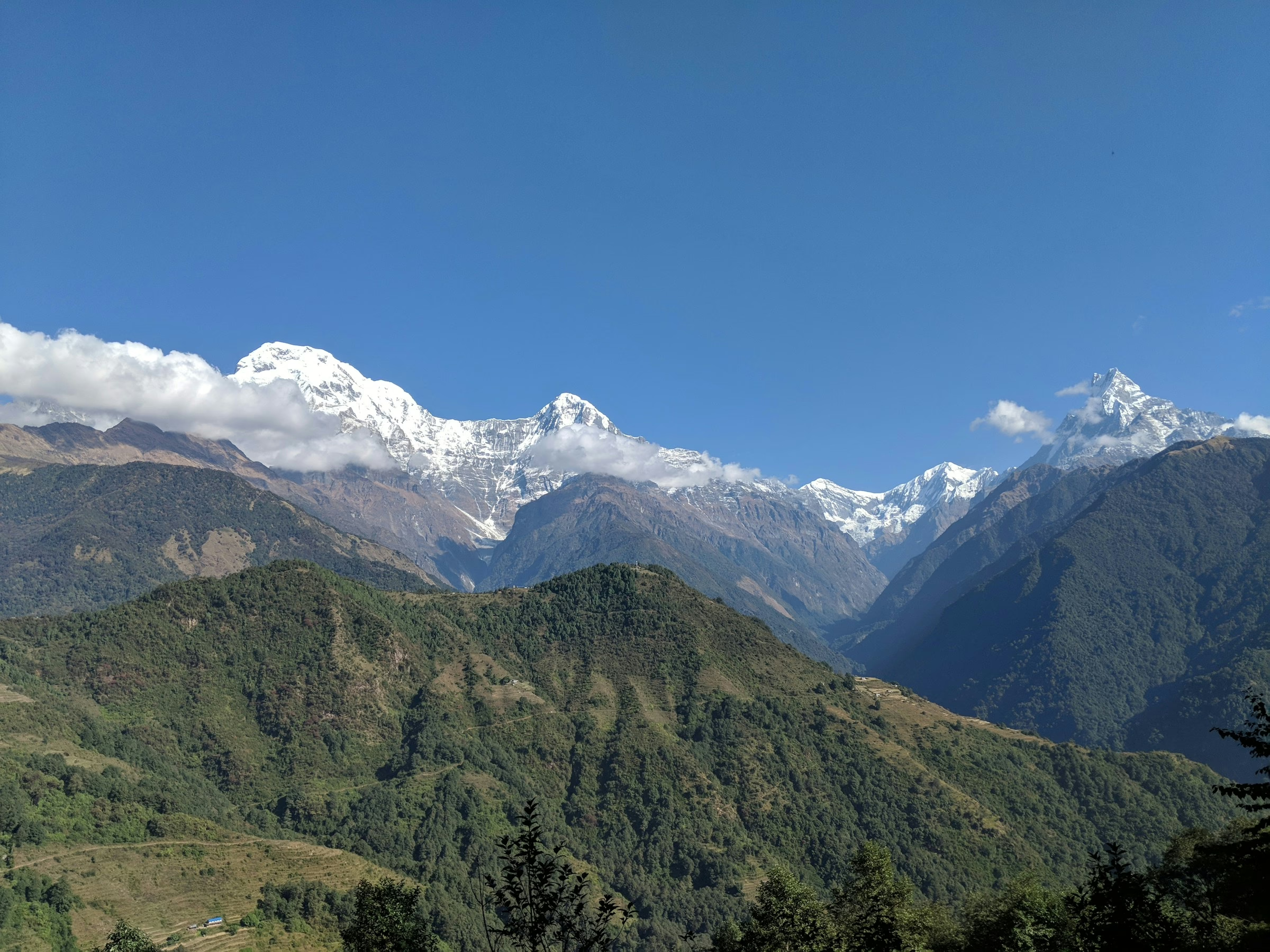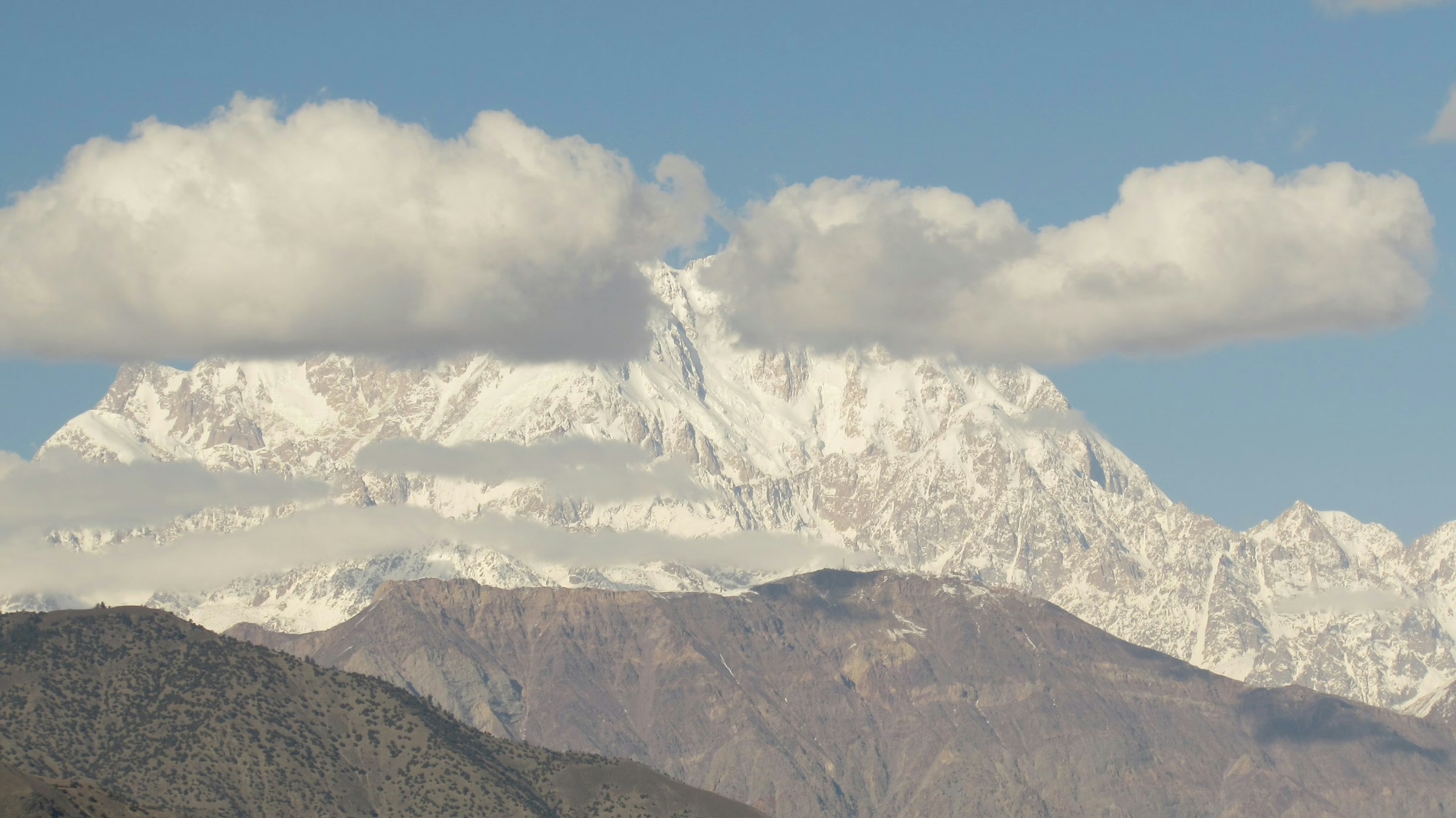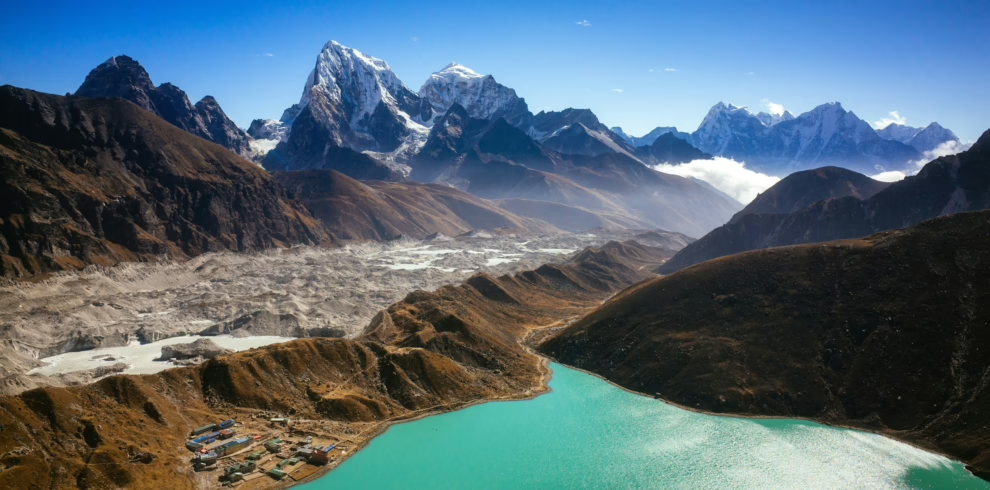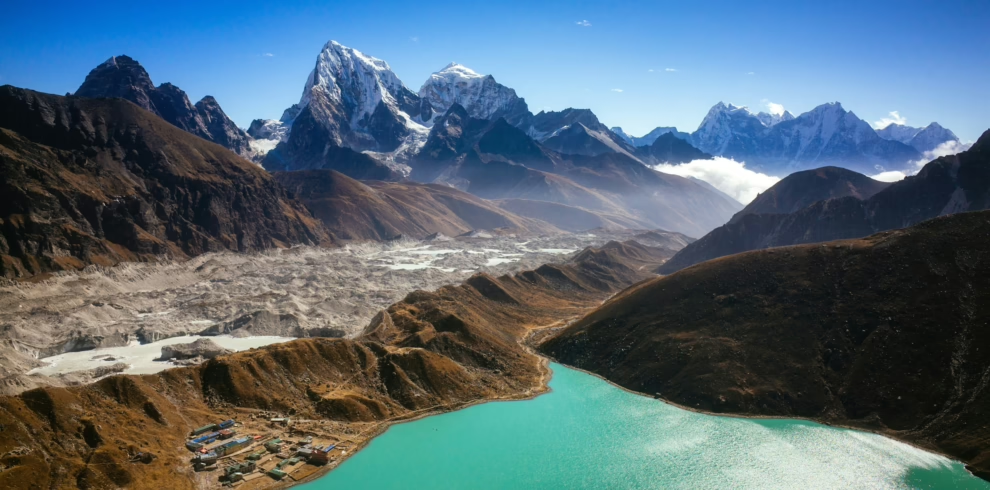Embark on an unforgettable 18-day Manaslu Tsum Valley Trek to the heart of the Himalayas, where you’ll explore the stunning Manaslu and Tsum Valley regions. This adventure takes you close to Mount Manaslu (8,163m), the world’s eighth-highest peak, offering awe-inspiring views of towering snow-capped mountains.
Tsum Valley, a serene pilgrimage destination, remains untouched by modern life, preserving its rich Tibetan Buddhist culture and timeless way of life. As you journey through this mystical landscape, you’ll immerse yourself in ancient traditions, witness daily rituals, and experience a deep connection to the region’s peaceful and devout inhabitants.
This trek is a unique exploration of Buddhist temples, sacred nunneries, and the sound of Tibetan horns resonating across vast valleys. With panoramic views of the Ganesh Himal and vibrant meadows, terraced fields, and spiritual communities, the Manaslu Tsum Valley Trek is a hidden gem of Nepal—an untouched paradise that reveals the enduring power of faith and the beauty of simplicity.
18 days / 17 nights Manaslu Tsum Valley trip
Trek Through Time in Nepal’s Manaslu Region
Highlights
- The region is home to Manaslu (8,163m), the world’s eighth-highest peak.
- Diverse communities such as Brahmin, Chhetri, Tamang, Magar, Tibetan, and Gurung live here.
- The area features forests of pine, oak, spruce, and rhododendron, and is home to endangered wildlife like the snow leopard and red pandas.
- Tsum Valley, a hidden gem, is a must-visit.
- Enhance your experience with excursions to Gumpa Langdang, Ganesh Himal Base Camp, Kal Tal, the Tibetan border, Pungen Gumpa, and Manaslu Base Camp.
- Enjoy stunning views of Mt. Manaslu (8,163m), Machhapuchhre (6,997m), Gangapurna (7,455m), Annapurna I (8,091m), Annapurna South (7,219m), and Annapurna III (7,555m).
- The Budhi Gandaki River Valley offers a unique blend of Nepalese and Tibetan culture, history, and lifestyle.
- The trail is less crowded, offering breathtaking mountain views.
- Visit ancient and spiritual Gompas, including Rachen Gompa, Mu Gompa, and Gumba Lungdang.
Itinerary
Upon your arrival at Tribhuvan International Airport, our representative will greet you and transfer you to your hotel in a private tourist vehicle. Once you're settled at the hotel, we will schedule a trip briefing at the hotel lobby or restaurant.
Your Manaslu and Tsum Valley adventure begins with an early morning public bus ride from Kathmandu to Machha Khola, passing through Arughat and Soti Khola. Along the way, enjoy scenic views of the Annapurna, Manaslu, Ganesh Himal, and Langtang Himal ranges, as well as terraced fields and lush green hills.
The route passes through Gurung and Magar villages, farmland, and cascading waterfalls before arriving at Machha Khola. You'll cross a suspension bridge into the Sal Forest, then climb a steep trail above the Budhi Gandaki River. After passing rice fields and the village of Labubesi, you'll reach Machha Khola, where you'll rest and prepare for the next day.
The trek from Machha Khola to Jagat involves several ascents and descents, making it a challenging section of the Manaslu with Tsum Valley route. From Machha Khola, you’ll pass through Tharo Khola to reach Khorlabesi, a scenic Gurung village. A short but steep climb leads to Tatopani, where you can relax in natural hot springs.
After crossing a suspension bridge over the Budhi Gandaki River and climbing stone steps, you’ll arrive at Doban. Continuing through Yaruphant, you’ll cross the Yaru River and then the Cantilever Bridge at Yaru Bagar—built with Swiss technology in 2016 after the earthquake.
To reach Jagat, you’ll cross the Budhi Gandaki again, ascend a hillside, and follow the trail down along the river. In Jagat, you'll register your permits at the police checkpoint—the entry point to the Manaslu Conservation Area.
Jagat is a large Gurung village situated on a flat plain. From here, you’ll ascend a rocky ridge to Salleri, where you’ll be rewarded with stunning views of Mount Sringi. The trail then descends to Sirdibas, a traditional Buddhist village, before crossing Nepal’s longest suspension bridge and climbing to Lokpa, located north of Philim.
After about an hour of uphill trekking through forested areas, you’ll reach Ekle Bhatti. As you continue through pine forests, the trail leads to a dramatic canyon and a fork. Take the right path toward Tsum Valley and stay overnight in Lokpa. From Lokpa, enjoy striking views of Himalchuli and Boudha Himal.
The trail passes through a quiet rhododendron and pine forest with several ascents and descents before reaching a small suspension bridge. This bridge leads to Ripchet and Chumling, where the Manaslu with Tsum Valley Trek route is redirected.
After crossing the bridge, you’ll walk past a small stone wall and arrive at the upper part of Chumling village, home to a monastery with views of Ganesh Himal. Chumling also features three notable monasteries: Panago Gumba, Mani Dhungyur, and Gurwa Gumba. A large chorten in the center of a field adds to the charm of the small valley.
The day begins with a suspension bridge crossing from Chumling to the opposite bank. The trail then follows the Syar River downhill to Domje. From there, you'll ascend steadily toward Chhokang Paro, passing through Rainjam and crossing another bridge to reach Gho Village, where a local teashop offers a brief rest stop.
After an additional two-hour hike, you'll arrive at the traditional village of Chhokang Paro. On clear days, you’ll be rewarded with distant views of Himalchuli and Ganesh Himal. Continuing from Chhokang Paro, you’ll pass through Lamagaon before reaching Rachen Gompa, your destination for the day.
After breakfast, you’ll begin a scenic walk from Rachen Gompa to the village of Nile, where lunch will be served. Afterward, you'll leave your main luggage at the teahouse and set out on a day hike to Mu Gompa—the largest monastery in the region and the highest point of the Tsum Valley.
Mu Gompa, nestled in a flat, bowl-shaped valley surrounded by mountains, offers a stunning and serene atmosphere. As there are no teahouses or lodging facilities there, accommodation is limited to basic rooms within the monastery. Therefore, after your visit, you’ll return to the Nile for the night.
Your trek will take you from Chhule to Phurbe, where you can stay in a Sherpa home. From there, continue along the Siyar River, passing through meadows and power lines to reach Rachen Gompa, a nunnery. On a clear day, you’ll enjoy great views of Kipu Himal. The route also passes through Chhokang Paro, Domje, Kowo, and Tanju, before reaching Chumling for your overnight stay.
After crossing the suspension bridge, begin a steep descent from Chumling to Lokpa village. The trek starts on a rocky hill with views of Sringi Himal in the distance. You will follow the Shair Khola's bank, passing farms growing maize, millet, potatoes, and vegetables. As you continue, enjoy stunning views of Ganesh Himal, Manaslu, and other snow-capped peaks. After crossing bamboo forests, you'll reach the Deng River, passing through a canyon and trekking along the Budhi Gandaki's bank.
Today, you'll hike from Deng to Namrung, starting with a climb to Rana Village, then continuing to Bhiphedi. The trail offers stunning views of Sringi Himal and crosses the Budi Gandaki River several times. As you approach Ghap, the trail winds through valley canyons and passes the Serang Khola. After leaving Ghap, the valley steepens as you ascend through bamboo and rhododendron groves.
Crossing a few wild rivers, you'll reach Namrung Village, the gateway to Upper Nuri, where Tibetans live and speak a distinct dialect.
The Manaslu with Tsum Trek ascends steeply from Namrung to Lihi, offering stunning views of Himal Chuli and Ganesh Himal. From Lihi, the trail descends to the Simnang side valley and then to the Hinang River, with Ngadi Chuli visible from a chorten along the river. The trek continues to Sho and then ascends to Shrip, where you'll encounter a large prayer wheel. After a challenging hike, you'll reach the ridge where Lho village sits.
From here, you’ll get your first views of Manaslu North and Naike Himal. Above Lho village, Ribung Monastery is worth a visit. Kani, a spot near Lho, offers excellent views for both sunset and sunrise. You can trek to Kani in the evening for the sunset, or wake up early to catch the sunrise over Manaslu Himal.
On the way from Lho to Samagaon, the trail passes through Shyala village. Your Manaslu Tsum Valley Trek will take you through gompas, Tibetan communities, and alpine landscapes, with stunning views of Mount Manaslu. Along the way, you'll also experience the region's rich cultural heritage.
Hike to Ribung Gompa and enjoy breathtaking views of the surrounding glaciers. You can also visit Birendra Lake, Pungyen Gompa, and explore the nearby glacial moraine. For a more relaxed visit, explore the Pungyen monastery beneath Manaslu's east face. Higher up, you'll find a cave gompa and hot springs.
We recommend spending a day in Samagaon to acclimate to the altitude. After dropping off your luggage at the teahouse, you can go for a hike to aid acclimatization. This day offers several great walking options.
Birendra Lake, a freshwater lake near Punhyen Glacier at 3,450 meters, is just a 3-kilometer walk from Samagaon. You can also hike to Manaslu Base Camp, the eighth-tallest mountain base camp in the world, located 6 kilometers from the village at 4,800 meters. Another option is Pungen Monastery, located 6-7 kilometers from Samagaon, where you can enjoy views of peaks, prayer flags, and mani walls.
You can aim to visit all three locations or at least two. The hike will return to Samagaon in the evening.
To reach Samdo, you'll ascend steeply on a remote trail. The Manaslu Circuit path follows the Budhi Gandaki River, passing through a beautiful forest of rhododendron, juniper, and birch trees. The valley widens as you approach Kermo Kharka and the white Kani Gateway, with mani walls lining the trail. Continuing on, you'll reach Samdo, just 4 kilometers from the Tibetan border. From here, enjoy stunning views of Mt. Manaslu, Simnang Himal, Ngadi Chuli, the Manaslu glacier, icefall, and other Himalayan peaks, along with a Tibetan refugee community.
Today, enjoy stunning views of the Larkya Glacier and the majestic Manaslu Mountain. At Larkya La Phedi, relax and prepare for the Larkya La Pass crossing the following day. The trek continues across hills and wooden bridges over the Budi Gandaki River, reaching the Larkya Glacier after crossing two streams and passing through a beautiful valley. You’ll then traverse the Salka Khola Valley, ascend again, and arrive at Dharmasala (Larkya La Phedi), a stone guest house that serves as a resting spot, not a full lodge. The short hike leaves ample time to acclimate to the altitude.
To tackle the longest and most challenging stretch, begin your trek from Dharmasala early in the morning. The Manaslu Tsum Trek starts with a gradual ascent across the moraine, followed by a descent to a lake. The trail then becomes rough and unclear, winding over steep grassy hills. After reaching the four frozen lakes, you'll face the final ascent to the pass, where you can enjoy views of Himlung Himal, Cheo Himal, Kanguru, Minjung, and the towering Annapurna II.
The route crosses the top of the moraine with steep, rugged switchbacks before descending gently on loose gravel to another grassy moraine. The path then becomes clearer, leading to a small meadow. As the trail continues downward, it passes a mani wall and a small rest hut marking Bhimtang, where the valley widens.
On the final day of trekking in the Manaslu region, the descent from Bimthang takes you through high grazing lands, Dudh Khola, and rhododendron forests, with views of Manaslu, Lamjung Himal, Himlung Himal, and Cheo Himal. After passing Dobhan and Purdi Khola, you'll descend to Hampuk village. From there, the trail leads to Gho Village, passing through Yak Kharka, Kharche, and the beautiful streams of Soti Khola and Kasongto Khola. Finally, after crossing Gho village and following the riverbank, you'll arrive at Tiliche.
Finally, you'll say goodbye to Tiliche and take a shared jeep to Besi Sahar. Along the way, you'll carry with you lasting memories and photos of some of the world's most stunning mountains. From Besi Sahar, you'll travel by public bus to Kathmandu or Pokhara, where you'll spend the night celebrating your successful completion of the Manaslu Tsum Valley Trek with a farewell dinner, sharing your experiences.
Includes/Excludes
Cost Includes
- Pickup from Kathmandu International Airport on your arrival date
- 1 night’s accommodation in Kathmandu with breakfast (before the trek)
- English-speaking professional trekking guide (includes meals, accommodation, salary, insurance, equipment, and transport)
- Taxi transfer to Kathmandu bus station
- Public bus ticket from Kathmandu to Machha Khola
- 16 nights’ twin-sharing accommodation in basic teahouses during the trek
- 1 night’s dormitory accommodation in Dharmasala
- All meals during the trek (breakfast, lunch, and dinner) with a cup of tea or coffee
- Sleeping bag for the trek (rated to -20°C)
- Green Lotus Trekking t-shirt
- Manaslu region pocket map
- Duffle bag for porter use (if porter service is selected)
- All required trekking permits for the Manaslu region
- Shared jeep from Tilche to Besishar (Day 18)
- Public bus ticket from Besishar to Kathmandu or Pokhara (Day 18)
- Government taxes, VAT, and service charges
- Purified drinking water (using water purification tablets)
- Free luggage storage at Green Lotus Trekking during the trek
- Farewell dinner in Kathmandu (upon return from the trek)
Cost Excludes
- International airfare, Nepal visa fee, travel insurance, extra accommodation/meals in Kathmandu
- Porter service (optional): USD 340 per porter (1 porter for 2 trekkers recommended; max 25kg per porter)
- Private Jeep from Kathmandu to Machha Khola (USD 200 per Jeep, optional)
- Private Jeep from Tilche to Kathmandu or Pokhara (USD 300 per Jeep, optional)
- Personal expenses during the trek (hot showers, extra meals, drinks, Wi-Fi, battery charging, etc.)
- Tips for guide and porter (customary and expected)
FAQs
With proper equipment, tools, and first-aid kits, we are fully prepared for any situation. Our crew members are thoroughly trained in first aid, and we carry oximeters to monitor oxygen levels at high altitudes. If a trekker becomes unwell, the trek leader will assess whether to continue or descend, prioritizing group safety. In emergencies, Lotus Trekking can arrange helicopter evacuation from high altitudes.
To minimize the risk of altitude sickness:
- Drink at least 4 liters of water daily
- Take garlic soup
- Walk at a steady, comfortable pace
- Do not skip acclimatization days
- Consider using Diamox (consult your doctor)
- Avoid caffeine, alcohol, and tobacco
You will need the following permits:
- Manaslu Restricted Area Permit
- Tsum Valley Restricted Area Permit
- Manaslu Conservation Area Permit (MCAP)
- Annapurna Conservation Area Permit (ACAP)
Green Lotus Trekking will handle all necessary permit arrangements on your behalf.
Yes, travel insurance is mandatory. It must cover medical emergencies, helicopter evacuation, and repatriation at elevations up to 6,000 meters.
The standard itinerary is 20 days. However, it can be customized to fit your schedule, whether you need more acclimatization time or have limited availability.
The trek starts from USD 1250 per person. This includes accommodation, meals, permits, transportation, guide, porter, and logistical support.
No, solo trekking is not allowed in this restricted region. You must trek with a licensed guide and at least one other person for safety and compliance with government regulations.
You’ll stay in basic teahouses or lodges offering twin-sharing rooms and local meals. Squat toilets are usually located outside the rooms. Hot showers and running water are available at some lodges for an extra charge.
While bottled water is available, plastic bottles are discouraged to reduce environmental impact. Bring a reusable bottle to refill with boiled or filtered water. Water purification tablets or drops are recommended and can be purchased in Kathmandu or brought from home.
After confirming your booking and deposit, please email us the following:
- A copy of your passport
- Passport-size photos
- Flight arrival and departure details
- Copy of your travel insurance policy
Your Manaslu Tsum Valley Trek begins with a journey from Kathmandu to Machha Khola, where you’ll enter the picturesque Budhi Gandaki region. Passing through terraced fields and small villages, you’ll reach Lapubesi. The trek continues through forests and communities, with a relaxing evening at the Tatopani hot springs. Along the way to Philim, enjoy stunning views of Sringi Himal. After passing Chumling, you’ll arrive at Chhokang Paro in Upper Tsum Valley, offering spectacular vistas of Ganesh Himal, Boudha Himal, and Himal Chuli.
Next, you’ll visit Piren Phu, a sacred site with Buddhist art and carvings, before reaching Nile/Chhule for exploration. Your trek continues to Mu Gompa at 3,700 meters, followed by the Rachen Gompa nunnery. The route then takes you through pine and rhododendron forests along the Siyar Khola to Gumba Lungdang. After some rest, you’ll head towards Ganesh Himal Base Camp.
From here, you’ll make your way to Lokpa, where accommodation options are limited. Your journey continues through Gurung and Thakali villages to Ghap, and then on to Lho. A rest day in Samagaon follows, before climbing towards Samdo, Dharmasala, and ultimately crossing the Larkya La pass at 5,160 meters. Your trek concludes with a descent to Dharapani and a bus ride back to Kathmandu, marking the successful end of your Manaslu Tsum Valley Trek.
Green Lotus Trekking Pvt. Ltd offers a professionally crafted 18-day Manaslu Tsum Valley Trek itinerary, including your arrival and departure days in Nepal. With our local expertise and dedication, we go above and beyond to provide you with a personalized and unforgettable adventure. For more details about the trek’s cost and itinerary, feel free to contact us.
Benefits of Booking the Manaslu and Tsum Valley Trek with Us
- Pickup and drop-off at the international airport
- Map of the Tsum Valley Trek itinerary
- Medical kits (provided if needed)
- Free storage for excess luggage at Green Lotus Trekking store during the trek
Preparation for the Manaslu Tsum Valley Trek in Nepal
Mountain trekking requires endurance and strength, which can be built through regular exercise. We recommend frequent hiking, running, gym workouts, or activities like walking, swimming, or cycling 4–5 times a week to help your body adapt to breathing and exertion. Hiking for 5 to 7 hours on local trails or small hills, with minimal breaks, will also prepare you physically for the trek.
- Physical Fitness: The Manaslu Tsum Trek is demanding, involving long hours of hiking on steep, rocky terrain at high altitudes. To prepare, start training several months in advance with cardio exercises (running, cycling, swimming) and strength training to build your legs and core.
- Gear: Ensure you have quality gear, including a durable backpack, comfortable hiking boots, suitable clothing, sleeping bag, camping equipment, stove, headlamp, sunglasses, sunscreen, hat, and gloves. Gear can be rented in Kathmandu if necessary.
- Logistics: The trek requires a special permit and a government-appointed guide. Plan ahead, as permits are limited and can be difficult to obtain. Booking a guide and porter in advance is advisable.
- Insurance: We recommend travel insurance that covers emergency evacuation, as the trek takes place in a remote area where medical assistance may be limited. Follow the acclimatization schedule to prevent altitude sickness.
The Manaslu Tsum Valley Trek offers an unforgettable adventure, but proper preparation is essential for a safe and enjoyable experience.
Useful Information for Manaslu Tsum Valley Trek
Best Season for the Manaslu Tsum Valley Trek
The ideal trekking seasons are March to May (spring) and September to November (autumn).
- Spring (March to May): Clear skies and blooming rhododendrons offer breathtaking views of Mt. Manaslu and surrounding glaciers. Snow melts by late March, making Larkya La Pass accessible.
- Autumn (September to November): Post-monsoon weather is stable with clear mountain views. This is a popular trekking time due to mild temperatures and dry conditions.
Meals on the Manaslu Tsum Valley Trek
Teahouses offer a variety of meals:
- Breakfast: Oatmeal, corn flakes, French toast, chapati, Tibetan bread, eggs, pancakes, fruits, and hot drinks.
- Lunch & Dinner: Dal Bhat (rice, lentils, and vegetables), momo, pasta, thukpa, Sherpa stew, Tibetan bread, soups, sandwiches, and vegetable curries. Meal options become limited at higher elevations.
Trek Difficulty
This is a challenging trek requiring 6–7 hours of daily hiking, often on rough trails and at high altitudes. Larkya La Pass (5,160m) is particularly strenuous. Cold temperatures, basic accommodations, and unpredictable weather add to the difficulty. Altitude sickness is a real risk, and solitude in remote areas increases the challenge.
Travel Insurance
Travel insurance is mandatory. It must cover:
- Emergency evacuation by helicopter (up to 6,000m)
- Medical and repatriation expenses
Submit a copy of your insurance policy to Green Lotus Trekking before your trek. While we don’t sell insurance, we can suggest providers based on client feedback.
Altitude Sickness and Prevention
The itinerary includes a rest day in Samdo for acclimatization. Trekking starts from lower altitudes, allowing gradual adjustment. Our experienced guides carry oximeters and are trained in first aid. Drink at least 4 liters of water daily, hike slowly, and follow your trek leader’s advice. In serious cases, descending immediately is the best treatment.
Recommended Packing List
Pack for both warm and cold conditions. Essentials include:
- Sun Protection: Sunglasses, sunhat, sunscreen
- Headwear: Warm hat, buff
- Clothing: Base layers, trekking shirts, fleece, outer jacket, rain gear, trousers, shorts
- Gloves: Inner and outer pairs
- Footwear: Hiking boots, socks, sandals, gaiters
- Bags: Duffle, backpack, daypack
- Sleeping Gear: Sleeping bag, liner
- Accessories: Poles, headlamp, microspikes, water bottle/bladder
- Tech: Camera, charger, books
- Health: First aid kit, purification tablets/LifeStraw, electrolytes, toiletries, sanitizer
- Other: Passport, cash, insurance, quick-dry towel
Guide and Safety Measures
Green Lotus Trekking prioritizes safety and environmental responsibility. We partner with the Kathmandu Environmental Education Project (KEEP) to promote sustainable travel. Our guides are trained in first aid and crisis response. In emergencies, helicopter rescue is available. Trek leaders have the authority to make safety decisions, including halting the trek if needed.
Booking Procedure
Green Lotus Trekking is a licensed tour operator and member of TAAN and NMA. To book your trek:
- Pay a 10% deposit
- Email us a copy of your passport, passport-sized photo, travel insurance, and flight details
You can pay via bank transfer, Western Union, or online. Upon arrival in Nepal, payments can also be made via cash, card, or bank transfer. We’ll provide full payment instructions upon booking.






